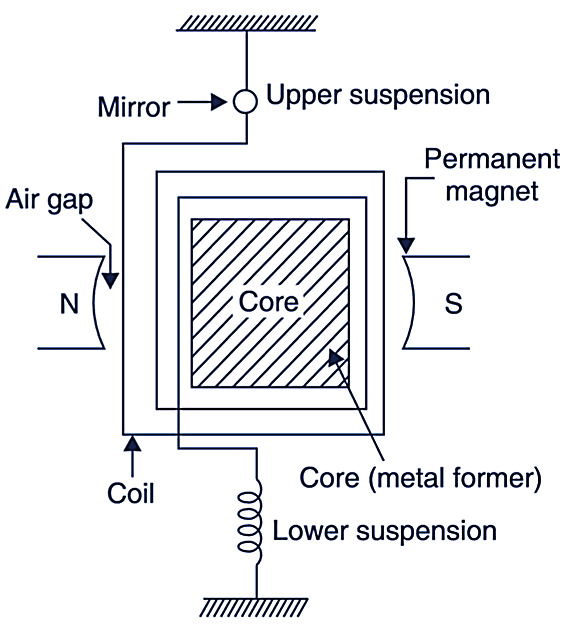D’Arsonval Galvanometer is the most popular and widely used galvanometer for detection and measurement of currents/voltages.

Fig. 1: D’Arsonval Galvanometer.
Construction of D’Arsonval Galvanometer
This is a moving coil permanent magnet type instrument. The coil of many turns wound on a metal former is suspended, so as to move about its vertical axis. The coil moves in the air gap provided between the pole pieces. The air gap is about 1.5 mm.
As the coil is wound on a non-magnetic (usually aluminium) former, the damping torque is provided by the eddy currents induced in the former during motion of the coil. This damping is very efficient and the instrument is dead beat. The damping can also be provided by connecting a low resistance across the galvanometer and the damping can be obtained by adjusting the value of the resistance.
The coil is suspended by a phosphor bronze filament which also acts as a lead for the coil. The other lead is a flexible spiral filament at the bottom of the coil. These filaments are also called upper and lower suspensions. The poles of the magnet are usually cylindrical in shape. By having cylindrical poles. the length of air gap is reduced so that the amount of flux linking with the coil is increased, this increases sensitivity of the instrument and the flux between the poles becomes radial. Moreover in a radial field, the deflection of the coil is directly proportional to the current in the coil and therefore a uniform scale is obtained.
Working of D’Arsonval Galvanometer
When the current to be measured is made to flow through the coil, a deflecting torque proportional to the product of flux density, current and dimensions of the coil makes the coil to rotate about its vertical axis. Now the suspension filaments produce controlling force and the pointer stops when the deflecting and controlling torques equal each other. As the deflecting torque is directly proportional to the current, the amount of deflection of the coil indicates the magnitude of current on calibrated scale.
On some galvanometers, a mirror is attached to the moving system. A light beam is reflected from the mirror on to a glass scale. As the coil is deflected, the light beam moves over the scale. The scale is about one (or half a) meter away from the instrument. The mirror eliminates the parallex. This also provides a high sensitivity of the galvanometer. The upper and lower suspensions are very weak and hence the instrument is not very strong mechanically, so the galvanometer needs to be handled carefully. A torsion head is provided for adjusting the position of coil and also for zero setting.
CONVERSION OF D’ARSONVAL GALVANOMETER INTO AMMETER AND VOLTMETER
The basic D’Arsonval galvanometer can be converted into an ammeter (to read currents) by connecting a small resistance in parallel with the instrument. This resistance is called shunt. The value of shunt is to be designed according to the range of the currents under measurement.
The basic D’Arsonval galvanometer can also be converted into a voltmeter (to read voltages) by connecting a high resistance in series with the instrument. This resistance is called multiplier. The value of the multiplier is to be calculated according to the range of the voltage under measurement.